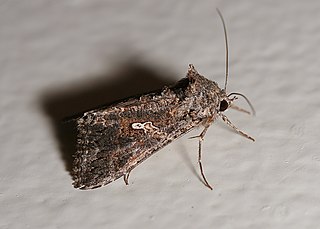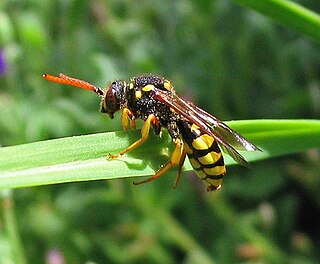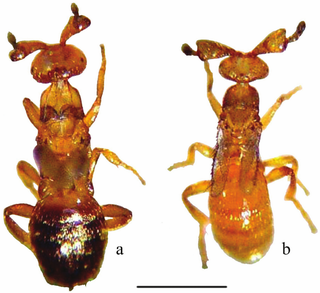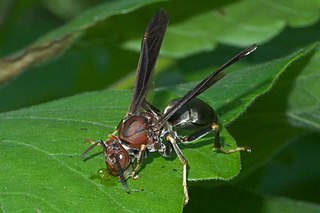
Megachile rotundata, the alfalfa leafcutting bee, is a European bee that has been introduced to various regions around the world. As a solitary bee species, it does not build colonies or store honey, but is a very efficient pollinator of alfalfa, carrots, other vegetables, and some fruits. Because of this, farmers often use M. rotundata as a pollination aid by distributing M. rotundata prepupae around their crops. Each female constructs and provisions her own nest, which is built in old trees or log tunnels. Being a leafcutter bee, these nests are lined with cut leaves. These bees feed on pollen and nectar and display sexual dimorphism. This species has been known to bite and sting, but it poses no overall danger unless it is threatened or harmed, and its sting has been described as half as painful as a honey bee's.

The organ pipe mud dauber is a predatory wasp in the family Crabronidae. It is fairly large, ranging from 3.9–5.1 cm, and has been recorded to fly from May to September. Females and males are similar in colour, a shiny black, with the end part of the back leg being pale yellow to white.

The cabbage looper is a medium-sized moth in the family Noctuidae, a family commonly referred to as owlet moths. Its common name comes from its preferred host plants and distinctive crawling behavior. Cruciferous vegetables, such as cabbage, bok choy, and broccoli, are its main host plant; hence, the reference to cabbage in its common name. The larva is called a looper because it arches its back into a loop when it crawls.

With over 850 species, the genus Nomada is one of the largest genera in the family Apidae, and the largest genus of cuckoo bees. Cuckoo bees are so named because they enter the nests of a host and lay eggs there, stealing resources that the host has already collected. The name "Nomada" is derived from the Greek word nomas, meaning "roaming" or "wandering."

The Eucharitidae are a family of parasitic wasps. Eucharitid wasps are members of the superfamily Chalcidoidea and consist of four subfamilies: Akapalinae, Eucharitinae, Gollumiellinae, and Oraseminae. Most of the 42 genera and >400 species of Eucharitidae are members of the subfamilies Oraseminae and Eucharitinae, and are found in tropical regions of the world.

Phthorimaea operculella, also known as the potato tuber moth or tobacco splitworm, is a moth of the family Gelechiidae. It is an oligophagous insect that feeds on the plant family Solanaceae and is especially known for being a major pest of potato crops. Currently farmers utilize insecticides, parasites, and sprinkler irrigation in order to prevent P. operculella from infesting their croplands.

The Culicinae are the most extensive subfamily of mosquitoes (Culicidae) and have species in every continent except Antarctica, but are highly concentrated in tropical areas. Mosquitoes are best known as parasites to many vertebrate animals and vectors for disease. They are holometabolous insects, and most species lay their eggs in stagnant water, to benefit their aquatic larval stage.

Spodoptera littoralis, also referred to as the African cotton leafworm or Egyptian cotton leafworm or Mediterranean brocade, is a species of moth in the family Noctuidae. S. littoralis is found widely in Africa, Mediterranean Europe and Middle Eastern countries. It is a highly polyphagous organism that is a pest of many cultivated plants and crops. As a result, this species was assigned the label of A2 quarantine pest by the EPPO and was cautioned as a highly invasive species in the United States. The devastating impacts caused by these pests have led to the development of both biological and chemical control methods. This moth is often confused with Spodoptera litura.

Aphomia sociella, also known as the bee moth and the bumble bee wax moth, is a small moth of the family Pyralidae and subfamily Galleriinae. Its body and forewings are typically reddish brown, tan, or dark green in color and females have a dark spot in the center of each forewing. The bee moth is native to Europe and are named "bee moths" because they seek out nests of bees and wasps to lay their eggs. Aphomiasociella are considered a pest because the bee moth larvae severely damage commercial bee hives. Bee moths are also studied for their unique mating ritual which includes a release of pheromones from both the male and the female along with an ultrasonic signal emitted through the male's tymbals.

Melittobia is a genus of hymenopteran insects of the family Eulophidae.

Polistes metricus is a wasp native to North America. In the United States, it ranges throughout the southern Midwest, the South, and as far northeast as New York, but has recently been spotted in southwest Ontario. A single female specimen has also been reported from Dryden, Maine. P. metricus is dark colored, with yellow tarsi and black tibia. Nests of P. metricus can be found attached to the sides of buildings, trees, and shrubbery.

Eucheira socialis, commonly known as the madrone butterfly is a lepidopteran that belongs to the family Pieridae. It was first described by John O. Westwood in 1834. Locally known as Mariposa del madroño or tzauhquiocuilin, it is endemic to the highlands of Mexico, and exclusively relies on the madrone as a host-plant. The species is of considerable interest to lepidopterists due to gregarious nest-building in the larval stages, and heavily male-biased sex ratio. It takes an entire year for this adult butterfly to develop from an egg. The eggs are laid in the month of June and the adults emerge the following May–June. The adults have a black and white pattern on their wings, and the males are generally much smaller and paler than the females. The larvae do not undergo diapause and continue to feed and grow communally in the coldest months of the year. There are two subspecies of E. socialis, named E. socialis socialis and E. socialis westwoodi.

Belonogaster petiolata is a species of primitively eusocial wasp that dwells in southern Africa, in temperate or subhumid climate zones. This wasp species has a strong presence in South Africa and has also been seen in northern Johannesburg. Many colonies can be found in caves. The Sterkfontein Caves in South Africa, for example, contain large populations of B. petiolata.

Mischocyttarus flavitarsis is a social paper wasp found in western North America. Their nests can be found both in forests close to rivers or in close proximity to human life under the eaves of roofs. Despite the fact that M. flavitarsis nests are frequently in close contact with humans, M. flavitarsis typically will not sting, but rather ram into the threatening individual. Their colony cycle typically begins before May and will last until October. The queen will then seek a hibernation site for the winter. Perched near female hibernation sites are males with whom the female will mate. The males have claimed their territory by rubbing sternal brushes along the border of the site, leaving a chemical that deters other individuals from approaching. M. flavitarsis feed on arthropods, nectar, and animal carcasses and are often prey to birds, ants, and praying mantis.

Callosobruchus chinensis, also known as the adzuki bean weevil, pulse beetle, Chinese bruchid or cowpea bruchid, is a common species of beetle found in the bean weevil subfamily. Although it is commonly known as the "adzuki bean weevil" it is in fact not a true weevil, belonging instead to the leaf beetle family, Chrysomelidae.

Tamarixia radiata, the Asian citrus psyllid parasitoid, is a parasitoid wasp from the family Eulophidae which was discovered in the 1920s in the area of northwestern India (Punjab), now Pakistan. It is a parasitoid of the Asian citrus psyllid, an economically important pest of citrus crops around the world and a vector for Citrus greening disease.

Pison spinolae, commonly known as mason wasp, is a solitary wasp of the family Crabronidae, native to Australia and found throughout New Zealand where it is an introduced species.

Hemileuca lucina, the New England buck moth, is a species of moth in the family Saturniidae. This moth species is only found in the New England region of the United States. Larvae in early stages mainly feed on broadleaf meadowsweet whereas larvae in later stages show variation in food sources such as blackberry and black cherry leaves. Larvae have a black body with orange/black spines on their back that are used to deter predators. Pupation occurs during the summer and adult moths come out around September.
Liriomyza trifolii, known generally as the American serpentine leafminer or celery leafminer, is a species of leaf miner fly in the family Agromyzidae.

Sceliphron asiaticum is a species of thread-waisted wasp in the family Sphecidae. It is native to the Neotropics, South America and the Caribbean region.



















